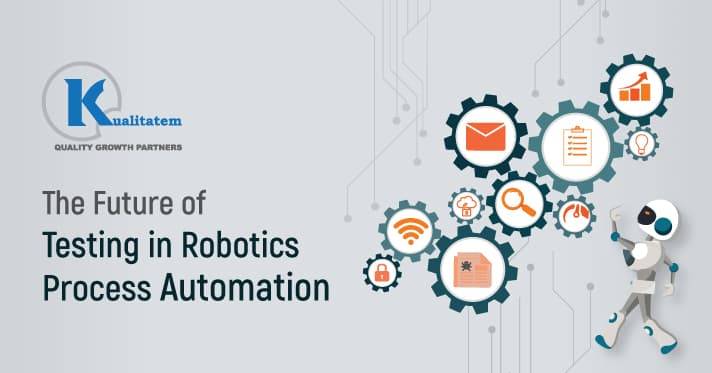The Future of Testing in Robotic Process Automation

- February 12, 2018
- Kualitatem
Robotic Process Automation (RPA) and software testing together are going to speed up the business-critical processes in the future. Conceptually, testing in Automation and Robotic Process Automation are somehow similar because they both include “automation,” fast product delivery, reduced human involvement, and quality assurance.
However, there lies a mega difference in between these two: Automation testing only tests a product, while RPA assists with other business processes such as SAP, ERP, and BPO practices to hold front and back office, HR, customer service activities, etc. The combination of software testing and RPA can prove to be an eventual holy grail of the QA industry.
First things first, let’s understand the concept of Robotic Process Automation:
What is Robotic Process Automation?
There are three words in RPA: “Robotic,” “Process,” and “Automation”, which refer to Automation testing processes run by Robots or bots. In broader terms, Robotic in the process will mimic the action of the users to enter data, follow a series of repetitive cases by observing and adapting right according to the environment and input provided by the users. It is an intelligent domain that requires vast programming knowledge and consistency.
How Does It Work?
In RPA, the user has to teach and train the robot accordingly in order to get a specific task performed. It is an easy process, you just need to own a powerful domain and enough programming knowledge.
It focuses on automation and syncs with the provided human inputs. RPA performs automated functions like data entry and manipulation, generating responses, and creating effective communication with other departments and systems included in the operation. It requires certain controls, protocols, tools, multiple levels of other components to complete a certain chore.
RPA uses the following tools and technologies:
- Blue prism
- UI Automation Tool
- OpenSpan Tool
- Automation Anywhere Tool
- C#
- DirectX9
- NUnit
- .NET 4.0
- Ace (IDE for V+)
- Robot Emulator
- UiPath
Future and Scope of RPA
As per Gartner, the requirement for RPA increases by 20 to 30 % every quarter. Furthermore, it predicts that by 2020, end-user spending on robotic process automation software will reach $1 billion, growing at a compound annual growth rate (CAGR) of 41% from 2015 through 2020.
In future, it is obvious that RPA will hold a prominent position in improving the ways businesses perform and rise.
It will let testers or other related professionals automate cumbersome data through a user-friendly interface. Modern business users can simply give the command to an already trained robot to perform a task.
These robots can and currently are functioning tremendously in the following areas:
- Accounting
- Data Entry
- Auditing and Monitoring
- Autonomous Invoicing
- Exchanging data between application systems
RPA in Testing
Importantly, RPA can facilitate the IT professionals in achieving high-end performance from their computing systems. It efficiently reduces the efforts put in end-to-end testing when structuring the custom APIs, collaborations, and business rationales to dissolve and resolve data silos.
RPA bots are taught task customization in the earlier stages. These bots can be trained to extract raw information and deliver it to the target code from front-end to back-end without causing any changes in the existing infrastructure. This mechanism reduces the paucity of a complex testing cycle chocked with custom APIs and integrations. This is how testers or developers both can focus their struggles and exertions on the core functionalities without wasting time on merging and managing APIs and Integrations.
Cutting the story short, RPA will play a fundamental role in the QA development and provide businesses with an opportunity to add more value to their underlying stability and scalability models with less investment and sweat.











